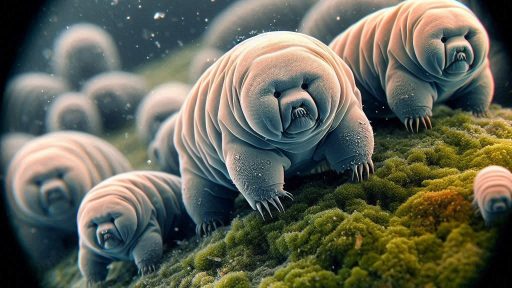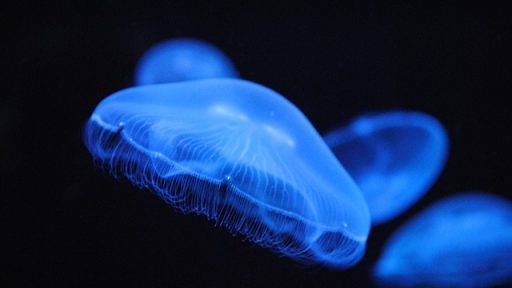Tardigrades, also known as water bears or moss piglets, are microscopic organisms that have captured the fascination of scientists and enthusiasts alike. These tiny creatures, measuring just 0.3 to 0.5 millimeters in length, are known for their remarkable resilience and ability to survive in some of the most extreme environments on Earth. Let's explore the fascinating world of tardigrades and their unique survival abilities. What Are Tardigrades? Tardigrades are small, water-dwelling micro-animals that belong to the phylum Tardigrada. They were first discovered in 1773 by German zoologist Johann August Ephraim Goeze, and their name "Tardigrada" means "slow stepper" in Latin. Tardigrades have a plump, segmented body with four pairs of clawed legs, giving them a bear-like appearance. Survival Superpowers Tardigrades are often referred to as "extremophiles" because of their ability to withstand extreme conditions that would be lethal to most other forms of life. Some of their incredible survival abilities include: Desiccation Resistance: Tardigrades can survive extreme dehydration by entering a state called cryptobiosis. In this state, they lose almost all their body water and curl up into a protective ball called a tun. This allows them to endure desiccation for years and revive when exposed to water. Temperature Tolerance: Tardigrades can endure extreme temperatures, ranging from as low as -272 degrees Celsius (near absolute zero) to as high as 150 degrees Celsius. Their ability to enter cryptobiosis and produce protective proteins helps them survive these temperature extremes. Radiation Resistance: Tardigrades can withstand high levels of ionizing radiation, including X-rays and gamma rays. Their DNA repair mechanisms and antioxidant proteins…
Longevity is influenced by a combination of genetics, lifestyle choices, and environmental factors. Interestingly, certain professions have been linked to longer life spans. These careers often come with benefits such as lower stress levels, better work-life balance, and access to resources that promote health and well-being. Let's explore some professions associated with longevity and the possible reasons behind their extended life expectancy. 1. Doctors and Medical Professionals Medical professionals, including doctors and dentists, often have a longer life expectancy. Their knowledge of health and wellness, access to medical care, and healthy lifestyle choices contribute to their longevity. Additionally, their daily routines may involve physical activity and mental stimulation, which are beneficial for overall health. 2. Teachers and Educators Educators, including teachers and professors, tend to have fulfilling and intellectually stimulating careers. The social interaction and sense of purpose associated with teaching can positively impact mental and emotional well-being. Additionally, educators often have structured schedules, allowing for better work-life balance and reduced stress. 3. Engineers and Architects Engineers and architects often work in intellectually challenging environments that require problem-solving and creative thinking. These mental exercises can promote cognitive health and reduce the risk of age-related cognitive decline. Moreover, many engineers and architects enjoy stable careers with good financial rewards, contributing to a lower-stress lifestyle. 4. Farmers and Agricultural Workers Farmers and agricultural workers typically engage in physical labor, which can promote cardiovascular health and overall fitness. Spending time outdoors and having a connection to nature can also reduce stress levels and improve mental well-being. Additionally, access to fresh, homegrown produce contributes…
Sexual health is an integral part of overall well-being, encompassing physical, emotional, mental, and social aspects. Understanding the relationship between sex and health can help individuals lead healthier and more fulfilling lives. Here are some key points to consider. 1. Physical Health Benefits Engaging in regular sexual activity can have several physical health benefits. It can improve cardiovascular health by increasing heart rate and promoting blood circulation. Additionally, sex can boost the immune system, helping the body to fight off infections and illnesses more effectively. Regular sexual activity has also been linked to lower blood pressure and reduced risk of heart disease. 2. Mental Health and Emotional Well-Being Sexual activity can positively impact mental health by reducing stress and anxiety. The release of endorphins and oxytocin during sex can enhance mood and promote feelings of happiness and relaxation. Furthermore, a healthy sex life can improve self-esteem and strengthen emotional bonds between partners, contributing to overall emotional well-being. 3. Hormonal Balance Sexual activity can help regulate hormone levels in the body. For example, it can increase the production of estrogen and testosterone, which play crucial roles in maintaining bone density, muscle mass, and overall vitality. Balanced hormone levels are essential for both physical and mental health. 4. Relationship Satisfaction A healthy sex life is often associated with greater relationship satisfaction. Open communication about sexual needs and preferences can strengthen intimacy and trust between partners. Satisfying sexual experiences can enhance emotional connection and contribute to a more fulfilling relationship. 5. Sexual Health and Safety Practicing safe sex is crucial for preventing…
The pursuit of immortality has long been a fascination among the wealthy and powerful throughout history. From ancient alchemists seeking the elixir of life to modern billionaires investing in cutting-edge technologies, the desire to conquer death and achieve eternal life continues to captivate human imagination. Let's explore some ways in which affluent individuals are currently pursuing the quest for immortality. Modern Pursuits of Immortality Biotechnology and Genetic Engineering: Advances in biotechnology and genetic engineering have opened new avenues for extending human lifespan. Wealthy individuals are funding research into gene editing techniques such as CRISPR, which have the potential to eliminate age-related diseases and enhance longevity. Cryonics: Cryonics involves preserving the body at extremely low temperatures after death, with the hope that future medical advancements will enable revival and cure of currently incurable conditions. Several affluent individuals have invested in cryonics facilities, aiming to secure a chance at future resurrection. Regenerative Medicine: Regenerative medicine focuses on repairing and regenerating damaged tissues and organs. Wealthy investors are supporting research into stem cell therapy, tissue engineering, and organ regeneration, with the goal of extending healthy lifespan and combating age-related decline. Artificial Intelligence and Robotics: Some visionaries in the tech industry are exploring the possibility of transferring human consciousness into artificial bodies or digital systems. This concept, known as mind uploading or digital immortality, envisions a future where human minds can exist independently of biological bodies. Health and Wellness Investments: Many affluent individuals prioritize their health and invest heavily in wellness programs, personalized medicine, and cutting-edge medical treatments. They have access to the best…
While no animal can truly achieve immortality, there are several species in the natural world that exhibit remarkable longevity and regenerative abilities. These creatures have captivated scientists and the public alike with their extraordinary lifespans and unique adaptations. Let's explore some of these fascinating animals and their secrets to a longer life. 1. The Immortal Jellyfish (Turritopsis dohrnii) The immortal jellyfish, scientifically known as Turritopsis dohrnii, has earned its name due to its unique ability to revert to its juvenile form after reaching adulthood. This process, known as transdifferentiation, allows the jellyfish to essentially restart its life cycle, potentially enabling it to live indefinitely. While this ability doesn't guarantee true immortality, it does provide an incredible example of nature's ingenuity. 2. The Ocean Quahog (Arctica islandica) The ocean quahog is a species of clam known for its impressive longevity. Some specimens have been found to be over 500 years old. These clams exhibit a slow metabolism and possess adaptive mechanisms that allow them to survive in harsh environments. Their long lifespans offer valuable insights into the aging process and potential ways to extend human life. 3. The Naked Mole Rat (Heterocephalus glaber) Naked mole rats are small burrowing rodents that display remarkable resistance to cancer and age-related diseases. They can live for over 30 years, far surpassing the lifespan of other rodents of similar size. Their cells have unique properties that allow them to repair damage more effectively, making them a subject of intense scientific study for understanding longevity and cancer resistance. 4. The Lobster (Homarus americanus) Lobsters possess the…
Okinawa, often referred to as "The Longevity Island," is renowned for the remarkable lifespan of its residents. This Japanese prefecture has one of the highest concentrations of centenarians in the world, and its residents often live healthy, active lives well into their 90s and beyond. Diet and Nutrition One of the key factors contributing to the longevity of Okinawans is their diet. The traditional Okinawan diet is rich in vegetables, particularly sweet potatoes, and includes plenty of tofu, seaweed, and fish. The diet is low in calories and high in nutrients, which is believed to promote health and longevity. Okinawans also practice Hara Hachi Bu, an eating principle that encourages eating until you are 80% full, thus preventing overeating and promoting a balanced diet. Physical Activity Physical activity is an integral part of daily life in Okinawa. Many Okinawans engage in regular exercise such as walking, gardening, and traditional martial arts like karate. These activities help maintain physical fitness, flexibility, and mental sharpness. Social Connections Strong social ties and a sense of community play a crucial role in the well-being of Okinawans. The concept of Moai, which refers to a lifelong circle of friends that support and care for each other, is a significant aspect of Okinawan culture. These social connections provide emotional support, reduce stress, and contribute to overall happiness and longevity. Sense of Purpose Having a sense of purpose, known as Ikigai, is another vital factor in the longevity of Okinawans. Ikigai represents the reason for being and gives individuals a sense of purpose and motivation in…
While no plant can truly achieve immortality, several plant species exhibit remarkable longevity and regenerative abilities, enabling them to survive for thousands of years. These plants have adapted to withstand harsh environmental conditions and possess unique biological mechanisms that contribute to their incredible lifespans. Let's explore some of these fascinating plants and their secrets to long life. 1. Bristlecone Pine (Pinus longaeva) The bristlecone pine, found in the high mountains of the western United States, is known for its extraordinary longevity. Some specimens are over 4,800 years old, making them among the oldest living organisms on Earth. These trees have adapted to survive in harsh, arid environments with poor soil, slow growth rates, and resistance to pests and diseases. 2. Methuselah Tree One of the most famous bristlecone pines is the Methuselah tree, which is estimated to be around 4,850 years old. It stands in the White Mountains of California and has been named after the biblical figure Methuselah, who is said to have lived for 969 years. 3. Quaking Aspen (Populus tremuloides) The quaking aspen is a unique species known for its clonal reproduction. A single organism can produce multiple genetically identical stems that share the same root system. The Pando clone, located in Utah, is one of the largest and oldest living organisms on Earth, estimated to be around 80,000 years old. Although individual stems may die, the root system can continue to produce new shoots, effectively making the organism "immortal." 4. Giant Sequoia (Sequoiadendron giganteum) Giant sequoias, native to California's Sierra Nevada mountains, are among the largest…
Jeanne Louise Calment, born on February 21, 1875, in Arles, France, holds the extraordinary record of the longest confirmed human lifespan: she lived for 122 years and 164 days, passing away on August 4, 1997. Her life spanned three centuries, and she witnessed immense changes in the world around her. Early Life Jeanne grew up in a well-to-do family, with her father being a shipbuilder and her mother coming from a prosperous milling family. She had a normal childhood for her time, learning piano and enjoying the arts. In 1896, at the age of 21, she married Fernand Nicolas Calment, a wealthy store owner. The couple had one daughter, Yvonne, who was born in 1898. Unfortunately, Yvonne passed away from pneumonia in 1934. Middle Years and Beyond After losing her husband in 1942 and her daughter in 1934, Jeanne raised her grandson, Frédéric, who later became a prominent doctor. Throughout her life, Jeanne led an active and independent lifestyle. She took up fencing at the age of 85 and continued to ride her bicycle until she was 100. Her long life was marked by remarkable mental acuity and a great sense of humor. Jeanne attributed her longevity to several factors: a diet rich in olive oil, chocolate, and wine, a positive attitude, and a daily routine of exercise. She claimed to have never smoked or drank excessively and maintained a cheerful disposition throughout her life. Later Years As Jeanne grew older, she gained international fame for her longevity. In 1988, at the age of 113, she became the world's oldest…







